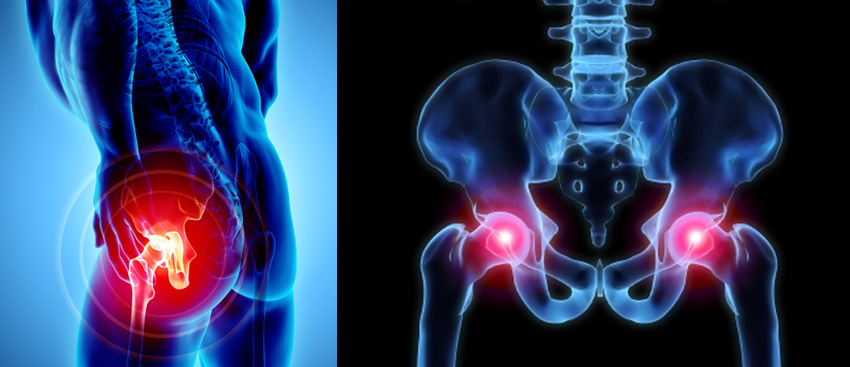
Hip pain is a common problem. Pain in or around hip can be caused by many conditions in and around hip joint. Patient can also get referred pain to their hips from lower back. Other problems in lower extremity can also cause hip pain due to improper gait.
Most Common Causes:
Muscle strain, Ligament sprain, Arthritis, Trochanteric Bursitis, Tendonitis, Laberal tear, Avascular necrosis, Tumor, Femoro-acetabular impingement, Nerve entrapment, Snapping hip, Joint replacement.
Symptoms and Signs:
Depends on your conditions patient will have different symptoms. Pain can happen inside hip, outer side, inner side and buttocks area. Inside joint pain is common with arthritis, avascular necrosis, laberal tear. Outer hip pain is common with trochanteric bursitis. Inner hip pain is common with groin strain. Buttocks area pain could be hip pain or radiating from back.
Patient will also complain of stiffness in the joint, restricted ROM and limp with many hip conditions.
Diagnostic Tests:
During the physical exam, your Doctor/Physical Therapist will check your Hip movement. He or she will check for muscle tightness and flexibility. He or she will also look for tenderness, swelling, gait abnormality, leg length discrepancy. Physician may take X-Ray and give medication before they order CT-Scan or MRI.
In certain cases physician may order arthrography, ultrasound, blood test, EMG/ NCV or other appropriate tests.
Treatment:
Most of the patients will respond very well with life style changes, try to avoid painful activity whenever they can, also can benefit from PHYSICAL THERAPY. Some patient will be advised to take pain medication over the counter or will be prescribed by their doctor. In acute cases the doctor might give a cortisone shot or other injection therapy to relieve pain. Patient may be also advised to put ice and rest.
What kind of Physical Therapy patient will get with Hip problems?
Besides explaining your hip injury and precautions to you, Physical Therapist will also try to relieve your pain using modalities like
- Hot packs
- Cold packs
- Electrical stimulation
- Ultrasound
Do manual therapy, which may include:
- Massage
- Soft Tissue mobilization
- Manual Traction
- Muscle Energy Technique
- Joint Mobilization
- Shoulder/Arm Fracture surgery
- Flexibility Exercises
- strengthening exercises
- Specific Home Exercises
Surgery:
Surgery is indicated mainly for fracture, joint replacement. Some patient undergo for laberal tear repair. Patient will need post-surgical Physical Therapy. Patient should try all conservative methods available before going for surgery whenever they can.
Prognosis:
Most of the patient will do very well with Physical Therapy and modifying life style, continuing active life style and in some cases specific exercises.
Prevention:
Maintaining healthy life style, keeping weight appropriate to age/gender and doing flexibility and other exercise can help. Runners should stretch and warm up before running.


